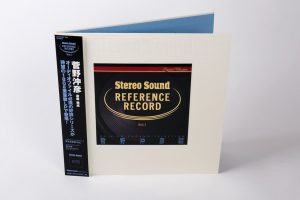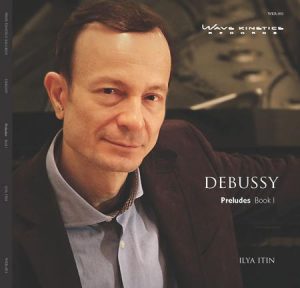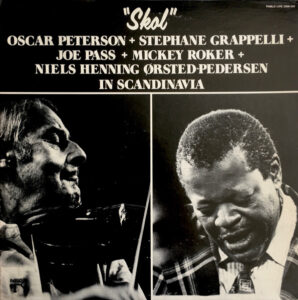GHOST is a Swedish band playing a genre of hard rock, formed in Linköping in 2006. In 2010 the band released its demo and then a complete album entitled Opus Eponymous. Since 2013, their album covers have been designed by the Polish graphic designer Zbigniew Bielak. We are reviewing the Japanese version of their latest album Impera.
GHOST is one of the most interesting bands playing heavy rock music today. It combines theatrical performances with quasi-satanic symbolism and committed lyrics. Its driving force is Tobias Forge, who has been with the band since 2010 and plays guitars, bass, keyboards and drums, as well as sings—he appears on stage in a costume as Papa Emeritus. He hired top people to record, mix, master and produce his latest album entitled Impera. Including the band, they have eighteen Grammy Awards under their belt.
The band
Already, the first album turned the metal world's attention to the band. The Grammy-nominated album was also noticed by the Kerrang! magazine which listed the song Ritual as one of the "50 Most Evil Songs Ever." The follow-up, Infestissumam, released in 2013, also received acclaim, debuting at number one on the Swedish metal albums chart and winning a Grammy for the "Best Hard Rock/Metal Album."
However, it wasn't until 2015's Meliora that the band gained financial independence—the album sold brilliantly around the world, ranking number one in Sweden and number eight (!) in the United States. The single Cirice, which was cut from it, brought the band a second Grammy Award in 2016, this time in the "Best Metal Performance" category.
Another album, Prequelle, was released in 2018. It was the group's best selling debut. The title sold in 66,000 copies in its first week, hitting number three on the Billboard 200 chart. The single Rats remained at number one on Billboard's Rock Songs chart for seven weeks and its follow-up for two weeks. The band released their fifth studio album entitled Impera on March 11, 2022.
The satanic motifs, especially visible on the first album, are largely a "costume"—this can be inferred from interviews with the band members. It is similar with the Papa Emeritus character they have created, who, like the Iron Lady of the group Iron Maiden, is the band's icon. They allude to this with theatrical performances that take their cue from such non-metal performers as Kiss, David Bowie and even Pink Floyd.
Music
GHOST owes its success to a skillful combination of often (seemingly, as it turns out) contradictory musical styles. Their scenic message, characteristic covers and, most of all, the subject matter of their songs, would tempt us to classify them as the Swedish black metal genre and that would be it. However, when we listen to the subsequent albums, it turns out that Ghost has been incorporating other elements into their music, which have nothing in common with black or doom metal. What is more, the band changes from one album to another.
This is why reviewers have trouble categorizing this music. There is talk of the two styles mentioned, right next to classic metal, but comparisons to progressive rock and even so-called "stadium rock" stand out much more strongly. Also confusing is the fact that this band's songs are not dominated by guitars. As we read in interviews, they are created as acoustic demos without instrumentation and are created together during rehearsals, which is why the whole thing sounds like the work of a band, not individual musicians.
Impera
GHOST RECORDS "THEMED" ALBUMS
On the previous one they focused on 14th-century Europe, and this time they are talking about, as we read in press materials: "rising and falling empires, self-proclaimed (financial and spiritual) messiahs, or prophecies." As it turns out, it couldn't have come at a better time—behind our eastern border, another "messiah" is trying to build his satanic empire...
TRACK LISTING
- Imperium
- Kaisarion
- Spillways
- Call Me Little Sunshine
- Hunter's Moon
- Watcher In The Sky
- Dominion
- Twenties
- Darkness At The Heart Of My Love
- Grift Wood
- Bite Of Passage
- Respite On The Spitalfields
In 2019, in an interview for the KLAQ radio station, Tobias Forge said he had had the idea for this album back in 2013. The impulse for it was reading Timothy Parsons' book The Rule of Empires: Those Who Built Them, Those Who Endured Them, and Why They Always Fall. However, he had to wait for its realization. And it wasn't until the band was to enter the studio in June 2020 that it was known that this was "the" moment. The album was supposed to be released in the spring of 2021, but first the U.S. presidential election and then pandemic problems caused the release to be postponed until 2022.
The band talked about the album in the following way:
"On Impera you will find Ghost transported literally hundreds of years forward after the 14th-century Black Death plague referenced on the Prequelle album. The result is the most ambitious and lyrically expressive album in Ghost's history. Over the course of the twelve songs contained on Impera, empires rise and fall, would-be messiahs proclaim their successes (both financial and spiritual ones), prophecies are foretold, and the sky is filled with divine, celestial man-made bodies. All of this is set against a hypnotic, melodic and dark background, making Impera something you haven't heard before. But, without a doubt, it is still Ghost."
THE RECORDING
Impera was supposed to be recorded still in 2020. The first recordings were supposed to take place in June, but they were postponed and the recording of the music did not begin until January 2021. The material was recorded—by rock standards—very quickly, as it took six weeks, from April to July, and the mix and mastering took another three.
Klaus Ahlund became the producer of the album. The recordings took place at three studios: Capitol Studios, Atlantis Metronome Studios and Apmamman Studio. Martin Erikson Sandmark and Stefan Roman were responsible for the sound. Mixing was done by Andy Wallace at Soundmine Studios. Mastering is by Ted Jensen of Sterling Studios in Nashville, USA; this took place in August 2021.
Soundmine Studios, a view of the SSL 4040 EG+ console, photo: Soundmine Studios
Klas Frans Åhlund is not only a producer and sound engineer, but also a musician, composer and multi-instrumentalist. He has received three Swedish recording industry Grammis with his band Teddybears, and although he is associated with rock, he has also produced songs by musicians such as Kylie Minogue, Britney Spears, Usher, Katy Perry, and Madonna.
Based in Pennsylvania, Soundmine Studios, where the album was mixed, offer a powerful SSL 4040 EG+ analog mixing console and work with DAW Pro Tools. Westlake BBSM 12 loudspeakers are used as the main monitors. Wallas, responsible for the mixing of Impera, has met with the group before, on the album Meliora.
It is one of the most well-known mixing and sound engineering specialists. He was responsible for the mixing of Nirvana's Nevermind, Coldplay's Viva La Vida, Evil Empire by Rage Against the Machine, Toxicity by System of A Down and Dirty by Sonic Youth. He also produced Slayer's album entitled Reign in Blood and the cult Grace by Jeff Buckley (more HERE).
An equally long list of accomplishments could be presented by Jensen, who mastered the album. There we would find Deep Purple, Santana, Sepultura, Marilion, Jean-Michel Jarre, Metallica, Björk and "all the saints" of pop, rock and metal music. He is the holder of seventeen Grammy Awards, including for Nora Jones' Come Away with Me album, and owner of Sterling Studios; he is currently one of the most sought-after mastering specialists and music producers.
Sterling Studios, photo: Sterling Studios
Sterling Studios is a mastering center operating in a hybrid system with a DAW station as the center and external analog peripherals such as compressors, limiters, equalizers, etc. The acoustics was designed by the French engineer Thomas Jouanjean.
THE RELEASE
Ghost's latest album has been released in several formats: as an LP, Compact Disc, as well as in files; there is also a cassette tape version. The Long Play is available in many different colors, both in a transparent and a filled form; even the cassette has three color versions. The CD has also been released in Japan (and this one we are reviewing here), and the record label also offers 24/44.1 WAV files. We can listen to the album from 24/44.1 FLAC MQA files on the streaming service Tidal.
The Swedish CD release comes on a black plastic disc, which is a nice reference to the group's roots. Japan offers a classic disc, but in a jewel box that is larger than usual. More space is needed to fit two booklets—an European and a Japanese one—as well as a small poster showing Papa Emeritus IV played by the vocalist.
The artwork on the cover and in the booklet is very impressive. And no wonder. Its author is Zbigniew Bielak, a renowned graphic artist now living in Warsaw, specializing in album covers of metal groups.
Zbigniew M. Bielak
I met Zbyszek many years ago. However, we have known each other only on the phone. He contacted me back then through Tomek, a member of the Krakow Sonic Society, who used to listening a lot of black metal at the past, to ask for advice on his audio system. Hours spent discussing tubes, vinyl, etc., brought little in terms of sonic aspects, but were a nice change from the "self-centered" conversations between two audiophiles that I usually have.
The cover of Paradise Lost album The Plague Within by Zbigniew Bielak, photo: Century Media Records
Today Zbyszek is an undisputed star in the music industry. The author of the monograph entitled Okładki płyt (Eng. Album Covers) says about him that "he creates intricate hand-made works set in a dark gothic atmosphere" and adds:
"He refers in them both to issues from the areas of religion, mythology, literature and architecture, as well as to the subject matter of the recordings themselves, [...] thus combining in his projects a creative dualism, stretched between being a cover author and simultaneously existing as a devoted fan of metal music."
Mateusz Torzecki, Okładki płyt, Poznań 2015, p. 204.
Among Bielak's clients, he mentioned Vader, Behemoth, Mayhem and Ghost (the Infestissumam album, 2013), and little did he know that this was only the beginning. In 2015, the Polish graphic designer's drawings were featured on the cover of Paradise Lost album The Plague Within, so they hit the absolute top.
SOUND
THE WAY WE LISTENED
The disc was listened to in the High Fidelity reference system. The CD version was played from an Ayon Audio CD-35 HF Edition SACD player, while MQA FLAC files were played from a Mytek Brooklyn Bridge file player.
A SHORT INTRO LASTING
1:40 entitled "Imperium" pretty well shows the direction the band and producers of the album have followed. It places the greatest emphasis on spaciousness and softness, as well as on momentum. All these elements are very rarely present on metal, or simply rock records of low quality. No wonder that this is what music fans are looking for, wanting to hear their favorites in a way that does not offend decency (we also talked about this years ago with Zbyszek Bielak).
And that is exactly what the Impera album sounds like. There is great space, long distances between planes and a wide panorama. Individual sound sources are not highly selective, but rather immersed in the acoustics of a given track. Tobias Forge's vocal is a bit further away from us, but it is presented in quite a clear way. The guitars on "Kaisarion," the second track on the album, are spread wide on the sides and do not have a sharp clear attack.
It is similar in the next track, "Spillways," which is slightly different, however. It has less space, the panorama is narrower, and the keys are more exposed, being the most important element in this track. We will return to the wide panorama in a moment, in "Call Me Little Sunshine." It is, by the way, one of the best tracks on this album. The delayed vocal sounds nice here, "matching" the vocalist—not on the axis, however, but on the sides.
And it was this treatment that confirmed a suspicion I had had from the very beginning, ever since I heard the album on Tidal—it seemed to me at the time that it was made with the help of some kind of a spatialization effect using phase shift. Perhaps that's why the sound of the new Ghost album is so similar to one of my favorite neo-progressive music albums, Sleepers by Galahad.
It is because this is an almost entirely rock progressive album. And even if, as in "Hunter's Moon," another very good track, we have slightly heavier passages, they are contrasted with quite cheerful passages played in major. More mystery is introduced only by "Watcher In The Sky," referring to the sound of Paradise Lost.
All of these songs have momentum, breath and beat. But this is soft beat and breath not of hell, but straight out of the American wilderness. It's like the soundtrack of a road movie played in the massive car system of a big truck. As if to confirm this intuition, track 7, which would open the B-side of the LP, features brass played on a synthesizer, and the next track begins with the sounds of a symphony orchestra.
But, but... The aforementioned "Twenies" in a moment turns into a dark dense rock track, played completely differently than the previous tracks, with strong guitar riffs. Maybe "strong" is an exaggeration, as the whole album has a soft sound, but it sounds like that against the background of the previous tracks. The balladic "Darkness At The Heart Of My Love" also goes towards the darker side, mostly in terms of mood. The exposed acoustic guitar is the dominant feature here and it "sets" the whole thing up.
The sound on this album is highly compressed, both at the level of individual instruments and in the mastering. However, it is also soft and pleasant. There is no shadow of sharpening, hard unpleasant edges, or squeezing everything on the listening axis. We also have good spatial planning. I think that each of these elements has been exaggerated, but the intention is clear, so I perceive it simply as a specific artistic creation.
A very good conclusion of the album is its last track "Despite On The Spitafields." There are a lot of nice guitars here, the drums are set up quite far away but with a strong footing, there is also low, round and warm bass. The vocal is fairly wide on the soundstage, which makes it clear. The whole thing is soft and shown in a wide panorama.
CONCLUSIONS
The idea for the latest album is totally different from the ones the band had for their previous albums. When I first heard it on Tidal, I thought they had included a Dolby Atmos version by mistake, forgetting to label it as such.
It turns out, however, it was no mistake. Impera sounds just like that. On the one hand it's great, because finally we have a strong rock album, but with a wide panorama, great depth and soft sound. On the other hand, however, the aggression, power and "punch" have been significantly softened. And this is probably not what we expect from this kind of music.
Musically, it's not a bad album, although I'll remain a fan of Ghost's earlier albums. Sonically, it's an experiment which may go in the right direction. Provided it can maintain the qualities I mentioned, adding more immediacy and energy, it will be excellent.
Record label: LOMA VISTA RECORDING/Universal Music LLC (JAPAN) UICB-10007
Premiere: 11.03.2022
Medium: COMPACT DISC, FLAC MQA 24/44,1
Sound quality: 7/10
PROGRESSIVE METAL MUSIC
listener WOJCIECH PACUŁA
translation Ewa Muszczynko
images Wojciech Pacuła | press materials















































